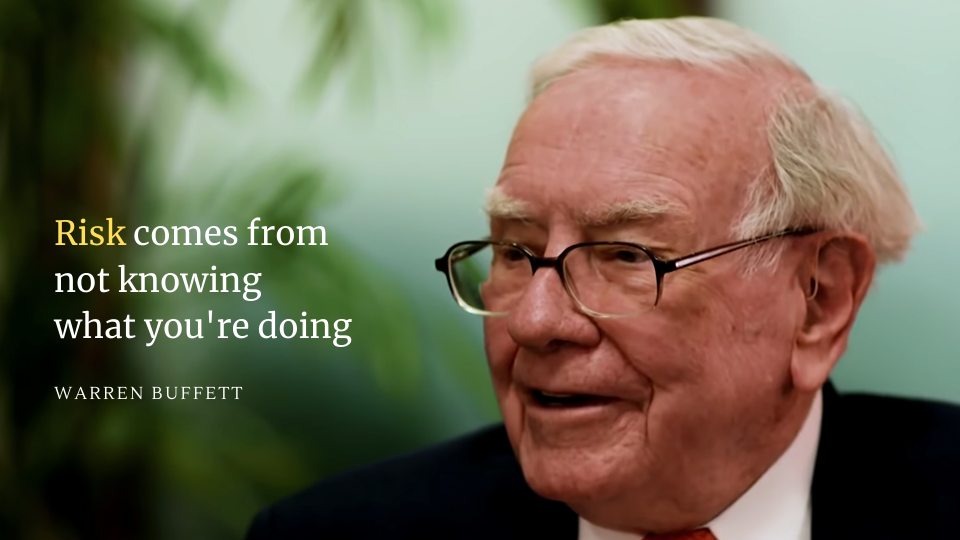Before I start to invest in the stock market, I have spent a few months learning how investing works and different approaches to invest. Fast forward until today, it has been one year and a month since I invested in the stock market.
However, I still feel that there are many things I don’t know about investing. I do believe that many investors will feel the same. The truth is, you don’t have to know everything about investing before you invest. But that doesn’t mean you can just start invest without knowing anything.
With that being said, I have chosen 10 things that I think are important for every new investor to know before invest.
Disclaimer: I am not a professional financial advisor or financial planner, so the information provided may not be 100% accurate. Nevertheless, I always give my best to share the most accurate information to my readers.
1. Why Invest in the Stock Market
Money can be invested in many ways. Other than stock, you can invest in property, fundraising, peer-to-peer lending, gold, and many more. But why invest in the stock market?
Become an owner of a company
By buying a stock of a company means you acquire a part of ownership in the company. With just one stock of a company, you have the right to
- Obtain the share of the company profits (via stock price appreciation and dividends)
- Attend the company’s annual general meeting (AGM)
- Vote for company management decisions during AGM.
For instance, if you bought one share unit of Facebook, you are now officially a shareholder of your favorite social media. If Facebook is earning profits and decide to distribute its profit as dividends, you will get the profit as well.
Low Entry, High Return
Read that again. It is low ENTRY, not low RISK ya. What I mean by low entry is you can buy one lot of shares (1 lot = 100 units) with a minimum of RM100. Compared to property investing (the investment that most parents approve), you need at least RM10,000 along with a huge loan to start invest.
In fact, investing in shares have proven to outperform other types of investment vehicles in term of capital growth. In other words, you will have the chance to obtain a return that is higher than 10% if you invest them wisely.
Though there is one downside to stock investing. As you can trade stocks frequently, you will face a lot of emotional challenges, especially with the volatility of the market. This will not be a case for property investment due to the long period required to sell a property.
2. How a Company/Business Works
By invest in the stock market, we are not just buying shares and selling them when their price rise. We are actually investing our money in a real company that has real employees and real business. Hence, it is important to understand how a business works.
To simply put, a business creates and provides values to others. When there’s a demand or a problem, this creates an opportunity for businesses to provide supplies or solutions. In return, businesses get revenue from their products. The cash flow allows them to expand and sustain their operations.
The key point is, it is crucial to know the products of the businesses and their industry. By understanding how a company works, you can hunt down companies that will make profits for you and the company.
3. How to Earn From the Stock Market

By understanding how one can grow money in the stock market, you can then plan well in your investing strategy. Basically, there are two ways to earn money in the stock market.
Capital Gain
When you buy a share from a company, the share price will fluctuate depends on the market sentiment and company performance. If the company earnings continuously grow, the share price will eventually rise as well.
For example, you bought a 1000 unit share of CIMB Bank for RM4,000 with a price of RM4 per unit share. After a year, its share price rises to RM5 and you decide to sell all the shares. (This is also known as realizing your gain) By selling 1000 units of CIMB Bank shares with a RM5 price, your return is RM5,000. As a result, you earn a capital gain of RM1,000, equivalent to a 25% return on your total investment.
Of course, the example above excludes the brokerage and transition fees. In reality, your profit will be less than RM1,000.
Dividends
When companies earn from their business, they can choose to share their profits by distributing dividends to their shareholders. Normally, the dividend is distributed between 1 to 4 times a year.
Let’s take CIMB Bank as an example again. You bought 1000 units of CIMB Bank shares with a unit share of RM4 each. The company then declared an interim dividend of 12 cents per share unit. As a shareholder of CIMB Bank, you will be entitled to receive dividends of RM120 (1000 x RM0.12) which directly cash into your bank account. A 3% return on your investment.
By receiving a dividend, the share price of the company will be adjusted by minus off the dividend amount from the previously closed share price.
4. How to Evaluate a Stock
There are two factors to be considered when picking a stock: quantitative and qualitative.
Quantitative Factors
By looking at the quantitative factor of a company, it is by evaluating a stock based on company financial figures. Revenues, profits, price to earnings ratio, return on equity, free cash flow, and dividends are usually things we consider when picking a stock.
It will be quite overwhelming at first when you just started to learn these figures. Give yourself some time to take note of each of them and learning one by one, you will understand how to apply them eventually.
Qualitative Factors
Qualitative factors include the company’s reputation, technologies used that gives competitive advantages, the sector or industry prospects, and the company management team capability. These factors cannot be measured by numbers but they are as important as quantitative factors.
In the early days of investing, I only focus on quantitative factors to choose a stock to buy. As a result, I ended up losing a few thousand when I put too much capital into one company with some management issues.
This company is known as ARBB (Aturmaju Resource Bhd). Financially, their profits are growing fast, but their share price is slowly declining due to nothing but memorandum and proposed projects. Investors start to lose trust in them and dispose of their shares.
From this experience, I realize how important qualitative factors are when evaluating a stock.
5. How to Read Financial Reports

There are mainly two types of financial reports: annual reports and quarterly reports.
Quarterly Report
- A summary of financial statements for 3 months (a quarter) that published once every 3 months interval.
- It includes the income statement, balance sheet, and cash flow statement.
- There is other interesting information provided such as the company’s geographical revenue, commentary on prospect and borrowing summary.
Annual Report
- It has more comprehensive corporate information than quarterly reports, such as general corporate information, CEO highlight, and management’s discussion.
- Similar to a quarterly report, it includes a summary of all the financial statements but with more details and charts in a few years comparison.
- There is also information on the company’s expectations of its business in the future.
Frankly, knowing how to read financial reports might not be necessary for most people. Many stock investing apps today provide several financial figures and charts that are enough for decision making.
Still, having the ability to read financial reports gives you an upper hand to grab more financial value and get a better insight into the company’s performance. That is why I consider this one important thing to know about stock investing.
6. Options to Invest in the Stock Market

Before I invest in the stock market, I thought it only means buying a company share. I didn’t know that there are many options that allow us to invest our money in the market. By buying shares of an individual stock, also known as equity, we only have the share of one company. Interestingly enough, there is also an investment option that you can buy which consists of multiple companies.
Exchange Traded Funds (ETFs)
ETF is an asset class that usually tracks an underlying index, which consists of a particular set of companies. Due to its nature, it is often a good option for diversification. If you have done some homework on investing, the S&P 500 is one of the most popular ETFs as it is recommended by the famous investor Warren Buffett.
In Malaysia, our local ETF liquidity is not as high as the US ETF. But I can start seeing many ETFs pop out in our country. I hope one day our ETF can perform as well as what we see in the US. Here is the summary of ETF and a list of ETFs from Bursa Malaysia.
Mutual Fund / Unit Trust
This might sound familiar to you if you have bankers who love to introduce you to their investments. A mutual fund or unit trust is a gigantic fund managed by a group of fund managers who invest in the market.
By investing your money in a mutual fund, you entrust your money to these fund managers with their expertise and experience to grow your money through investing. In return, they will charge you a management fee. Hence it is important to know their historical performance and management fees before you invest in their fund.
Amanah Saham
This is a local trust fund founded by a government-linked investment company – Permodalan Nasional Berhad. There are two types of funds in Amanah Saham: fixed-price funds and variable-price funds. To see the full list of these funds, you can visit Amanah Saham’s official website.
In my opinion, this is an excellent investment option for most Malaysians as it provides good returns and does not require any investing knowledge. The only challenge lies in the difficulty to buy their fund shares.
If you are a Bumiputera, you have the privilege to invest up to RM200,000 in their special fund known as Amanah Saham Bumiputera. My no-brainer advice for you is to maximize this fund as soon as possible.
If you like to learn more about other investment options, I will leave you with Mr-Stingy’s article of Ultimate Guide on DIY Investment Options in Malaysia.
7. Different Investing Approach

Every goal needs a plan, and this includes investing. There are all kinds of investment methods, but I will brief you on these 3 common ways of investing.
Dividend Investing
Dividend investing is all about investing in stocks with high and growing dividends. Usually, dividend investors always aim for companies with a dividend yield of more than 4% annually.
This investing method is very beginner-friendly as it has a lower risk. Companies with high dividends usually are large companies with stable revenues and less volatile share prices. Besides that, seeing your dividend grows over years can be really motivating for investors. The only downside is its lower return compared to capital gain.
Value Investing
An approach used by many famous investors such as Benjamin Graham, the father of value investing, and Warren Buffett. By determining the intrinsic value of a stock, they look for undervalued stocks and hold them for the long term, at least 5 or 10 years.
This investing method is quite effective as it does not require too much attention to look at your invested companies and hence price fluctuation does not impact you much. However, it is boring for some people due to its nature of holding stocks for the long term and delayed gratification.
Growth Investing
Growth investing is an approach that targets young or small companies that have high earnings growth to focus on getting those capital gains. If the money is wisely invested in potential companies, the return of this investment will usually be higher than the average market return.
Stick With It
These 3 investing strategies are the common ones used by most investors. Often time, investors will use a combination of these approaches to achieve their expected returns.
More importantly, you should have your very own investing strategy. Then, write them down and stick to it. Following your investing plan allow you to be unshakeable during the worst time of the market.
8. Asset Allocation

Do not put all your eggs in one basket.
This will be the quote you will often hear in your investing journey. It means that we should not invest all our money into one company. If anything happens to that company, your whole capital invested will be affected. Therefore, diversification in several companies helps to reduce your risks when you invest in the stock market.
Other than investing in stocks, there are other asset classes that we can invest in such as commodities (such as gold), bonds, fixed deposit, or even high-interest savings account. Diversification can be further improved when we allocate some of our capital to different asset classes, this is known as asset allocation.
Asset allocation reduces our capital risk by lower the exposure in the stock market. At least part of our capital is unaffected when the market is having a bad day.
9. Risks of the Stock Market

There are two types of risks in the stock market: systematic risks and unsystematic risks.
Systematic Risks
Systematic risks are external factors that usually cannot be avoided. These are examples of systematic risks:
- Political Instability
- Natural Disaster
- Economy Crash and Recession
- Fluctuation in Currency Rates
- Wars
Unsystematic Risks
Unsystematic risks are usually company-specific or industry-specific. These are examples of unsystematic risks:
- Company Management Shift
- Strikes
- Bribery cases
- Product Failure
- Fraudulent Activities in Financial Statements
We cannot entirely remove these risks from the Stock Market, but we can reduce them. A well-diversified stock portfolio will help to reduce unsystematic risks, while systematic risks can be reduced by asset allocation.
10. Brokerage Firm in Malaysia

After you have covered all the basics above, all you are left to do is to choose a brokerage firm so you can start trading stocks. There are a lot of brokerage firms available in Malaysia. Some are local banks, some are independent security companies that provide brokerage services.
When choosing a brokerage firm, these are usually the factors that you should consider:
- Brokerage Fee
- Market Exposure (Foreign Share Trading)
- Online Access
- Service Quality
- Account Type
Indeed, the brokerage with the cheapest brokerage fee helps us to maximize our gains. However, it is wise to look at other factors as well. There are brokers that allow you to trade shares from other countries such as Singapore and the United States. You should consider this factor if you are interested to invest in other countries. On top of that, you should also consider a brokerage firm that provides good service and online trading.
Account Type
There are two types of CDS account: direct and nominee. A direct account means that every share transaction via the broker will be under your own CDS account. You will be the direct owner of the shares you bought and enjoy certain rights as a shareholder which includes voting rights and the right to attend AGMs/EGMs.
While for the nominee (trust) account, the brokers will trade shares under their CDS account on your behalf. You can still obtain the basic right of a shareholder such as receiving dividends and bonus issues, but you need to submit a request to your broker if you want to attend AGM, have voting right or receive a copy of your invested company annual report.
If you have no idea which brokerage account to choose, you can check out iMoney’s page for a great summary of all share brokerages available in Malaysia.
Personally, I use M+ Online as my direct brokerage account.
Read More: How to Open a CDS Account in Malaysia with Bursa Anywhere
Conclusion
I can totally understand when you feel overwhelmed to digest all of them in one day. I’ve been there too, and it took me almost several months to have the confidence to invest in the stock market.
In fact, it is OKAY to take your time to slowly learn all of them. No need to be rush. As they said, slow and steady wins the race. Moreover, invest your money recklessly into the Stock Market without proper knowledge is just pure gambling. As Warren Buffett said:

Remember, stock investing is not a get-rich-quick scheme. You should imagine it as you are planting trees (your retirement fund) with your seeds (your money). It will surely take some time, but the results will be satisfying.
Furthermore, stock investing will open a door for you to financial independence. You definitely won’t regret learning it!
Phew! I think I have written this article a bit longer than I thought. If you have any questions related to this topic, feel free to comment below. I would love to have discussions and take this chance to learn more together! 🙂
Blog Update & Social Media
If you like this article, then you may like my other articles as well. Feel free to subscribe to my newsletter so you can get the latest update from me when I posted a new article. 🙂
[mc4wp_form id=”236″]
Also, you can also get my new blog post updates by following my social media below. Don’t be shy and feel free to interact with me as well. See you there!

hi marcus, thanks for the great article…it definitely lightens my path to stock investment. But i have one question…there are so so so many stocks available in Malaysia….how do u narrow down your choices?
Hi Li Wan. First, you need to know what type of return you prefer? Capital gain or dividend?
If you seek dividend stocks, then you can screen through all the stock by Dividend Yield that has more than 4 or 5%. That is how I filter a long list of stocks.
It will definitely take some time to find your preferred stock. Good luck!
Excellent tq for the information esp in this trying times
You’re welcome 🙂
Great write-up, Marcus!
Just curious, which investing approach did you personally use?
Mat Kewangan
Hi Mat! Thanks! Most of my stock portfolio is growth stocks with a little bit of dividend stock. 90% growth investing, 10% dividend investing. It’s an aggressive approach.
Thanks for the great write-up, Marcus! Definitely helpful for a beginner like me 🙂
You’re welcome! I glad it does! 😄